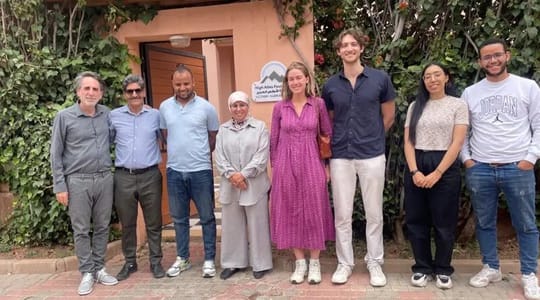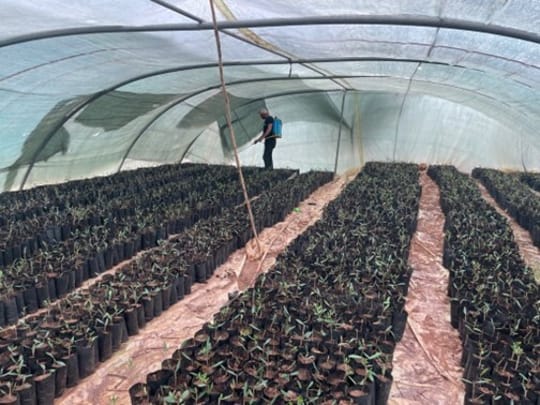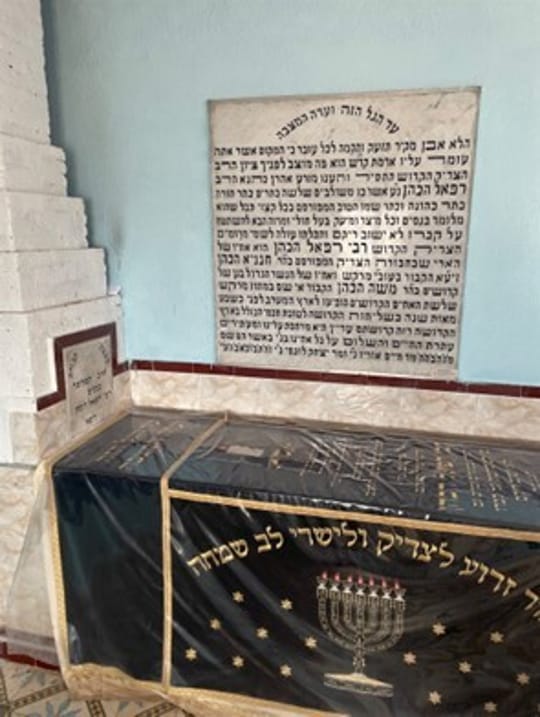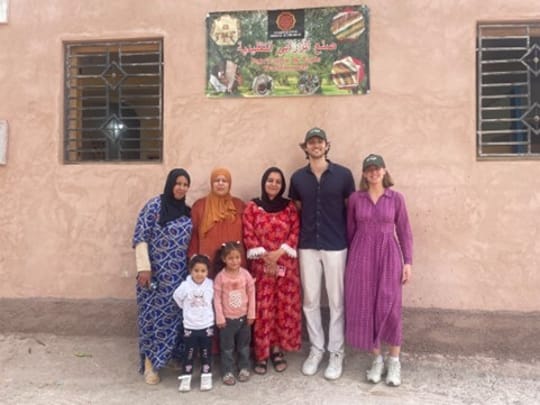Roots of Change: A Journey Through the High Atlas Foundation’s Projects in Morocco

As I climbed the stairs leading back to the road, I passed the stone graves––red, grey, and inscribed with Hebrew, sheltering the dead on my left and the greenhouse tents––covered in thick tarps, full of thousands of tiny trees budding with new life on my right. At the top of the hill, I turned to look back across the sparse hills rolling across the desert when a light breeze fell and the pomegranate plants bowed. Through a haze I could see the Atlas Mountains loom on the horizon.
I had hoped to be here years ago, four to be exact, when I was a student at the University of Virginia and an intern for the High Atlas Foundation (HAF), but that was 2021 and COVID still had the world in its grip, so instead of spending the summer on site in Marrakech, Morocco, I worked from my laptop in Oakton, Virginia. As a remote worker I attended virtual conferences and group discussions, and wrote articles on a variety of topics under the guidance of HAF president Dr. Yossef Ben-Meir. At the end of my internship, I had learned a lot about the region and the goals of the people who live there, but I couldn’t help but feel disconnected and lacking in cultural understanding.
However, a few weeks ago, I finally got to meet Yossef in person and see a few of the foundation’s project sites firsthand.
My girlfriend Liv and I flew from New York City, to Lisbon, and finally to Marrakech for a four day visit. We took a taxi from our hotel in the center of Marrakech to the southern outskirts of the city where we found the HAF office in a beautiful, quiet neighborhood. We were greeted by a smiling man with long silver hair in a grey button down shirt and slacks. I recognized his face and his voice immediately from my computer screen four years ago.
Yossef welcomed us to the office and guided us to the conference room. Surrounded by knicknacks from Austin, Texas of all places and bathed in natural light from the tall windows the three of us had a lovely conversation. Liv and I spoke about our lives in New York, mine as a writer and a musician and hers as an architect, and Yossef told us about his travels as well as HAF’s work in recent years with tree planting and water projects. As the conversation wound down and Yossef had to get back to work, he generously offered to have his driver Hassan take us to visit some of the project sites.
We thanked Yossef, said our goodbyes, and hopped into the back of Hassan’s car for an entirely unexpected and exciting journey into the rural Atlas region.
On our way out of the city, we stopped for a quick meal of beans, bread, and cooked vegetables on the side of the road. Liv and I ate ravenously as Hassan chatted with the cook and paid for our food. After drinking our mint tea we were back in the car driving off into the desert.
Hassan was a thin man with a thick black mustache and glasses. He wore a blue button down shirt tucked into dark pants and dress shoes. He informed us that he didn’t speak any English, only French and Arabic as most Moroccans do. Liv was able to speak a little French with him, but it was clear there were going to be some issues communicating.
For 20 minutes we drove in silence. Outside, untouched, flat land and the occasional house flew by as warm air swept through the cracked windows. We exited the highway and wound down onto a dirt road through a half built town. The road lowered into the beginning of a valley where we stopped and exited the vehicle. We had arrived at Akrich’s Jewish Cemetery and Tree Nursery.
We were greeted by a stout man with a thin black mustache and a baseball cap on his head who shook our hands and welcomed us with friendly eyes. This, Yossef had told us, was the caretaker, Abderrahim Beddah, the third generation guard of this holy site after his father and his grandfather.
Abderrahim led us through a flap and into one of the greenhouses. Inside, I was immediately struck by the heat and humidity. I ran my fingertips across the tent ceiling where countless droplets had collected. At my feet were thousands of tiny plants arranged in rows covering nearly every inch of the ground.

HAF greenhouse with thousands of olive trees. Photo Credit: Noah Ginsburg
Our method of communication was a game of telephone. Abderrahim spoke Arabic to Hassan, Hassan then translated it to French to Liv, who then communicated the message to me in English. Though many words were lost in translation, I learned that these were young olive trees––8,000 in this tent alone. While we spoke, another man walked amongst the baby trees spraying them with a hose, carefully stepping over and between them. I wiped the sweat off my face as we stepped back out into the sun.
Abderrahim then showed us an olive tree a little further along in the growing process. Though still young, this tree was about four feet in length from the tip to the soil casing in the caretaker’s hands. These casings which hold in the soil and serve as the base of the tree, he explained, are made of sustainable material which can be planted directly into the ground allowing the tree to grow around and through it.
This tree nursery is responsible for the planting of tens of thousands of trees, an incredible feat that was made possible by the support of HAF. The foundation provided the trees, dug a well for irrigation, and installed solar panels to power the system.
We were then led around the tree nursery and down to a room with a tiled floor. Light shone in through the doorway and a few small windows illuminating blue walls, red cushions, and, in the corner, a large piece of stone covered in Hebrew writing. This was the 700 year old tomb of Rabbi Raphael Hacohen.

The 700 year old tomb of Rabbi Raphael Hacohen. Photo Credit: Noah Ginsburg
Opting for a more efficient mode of conversation, I downloaded a translator app on my phone and was able to have a brief conversation with Abderrahim.
He explained that the Rabbi’s tomb is a site where Jews from around the world come to visit and pray, a site so special and sacred not only for its saintly resident, but for the fact that this holy Jewish place is located in an Arab country and is guarded by a Muslim. Abderrahim expressed his wish for people to know that.
“Surely there is room between life and closeness, between life and death and quarreling,” he said. “We have lived in peace, side by side, for generations.”
He showed us photos from visitors, pictures of children, spouses, and parents, who had all made the trip to this cemetery built into the side of the hill, sheltered from the desert, quiet, and timeless.
“Did you not feel something in your body when you came here?” he asked.
At the top of the hill, looking down at the graves and back at the greenhouses, after shaking hands with the humble caretaker, thanking him, saying our goodbyes, and opening the door of the car to leave, I felt the weight of his words.
Back in the car I scribbled notes into a lime green notebook as we drove to our next destination. When we exited the car for the second time, the sun was still high in the sky. We stood at the foot of a building nestled amongst tall trees and were greeted at the door by a woman in a black hijab dressed in red. She smiled and welcomed us into the Ourika Women’s Cooperative.
Inside, we were greeted by the sounds of humming sewing machines, laughing and shouting children, and low conversation amongst the women. At one table a woman worked on the sustainable soil casings we had just seen at the tree nursery, a neat stack of the light brown bags sitting on the corner. Along the front wall of the room, another group of women worked on rugs. Seated before a tall rig with two wooden pieces running horizontally and dozens of white strings running vertically, the women wove gorgeous patterns of white, pink, yellow, and blue out of yarn made and colored by hand. They showed us bowls of raw materials used to create the yellow yarn color, the purples, the greens.

The natural pigments. (HAF photo, 2024)
I tried to use my translator app to speak with the women but found no cell service, so they took us three stories up to the terrace where I might have better luck. They arranged chairs for us to sit as I paced around the roof with my phone to the sky, feeling very much like a fool. Finally I located a bar of cell service and was able to have a brief discussion.
They emphasized the value of the cooperative, a place where they can work and earn money, gather and talk to one another, cook and share meals. I asked where they learned the skills they employ here. They told me they have been passed down for generations but now, due to the cooperative, they have the opportunity to make money from them.
One of the women I spoke to, Sanaa, told me she has three daughters who are in school, but who she will also teach the same skills to. “My hope is that they will have a better future than the one I have now,” she said.
They led us down from the terrace to a room dancing with color. Handmade rugs lay across the floor with intricate patterns, no two the same, with two great white tables low to the ground surrounded by cushions. We took our shoes off at the edge of the rugs and sat cross legged around one of the tables while the women brought us mint tea and plates of food. They brought Msemmen, a traditional flatbread, bowls of honey, jam, and black olives, plates of eggs and Khobz, a round bread. The food was extraordinary and, though we couldn’t speak to one another around the table, we smiled and laughed as if it didn’t matter at all.
Outside the house, in the shade of the olive trees, we waved goodbye and thanked our gracious hosts. Hassan drove us back to the city and let us out at the red wall of the palace. We thanked him heartily for his guidance throughout the day’s journey and for his patience as we worked to communicate with one another.
The Akrich Tree Nursery and Ourika Women’s Cooperative, are just two of the High Atlas Foundation’s development projects, but they reveal so much about the foundation’s goals and its method. HAF works with communities to better understand their needs and help to address them. It builds on what is already there such as women with skills that can be used to further their own financial independence and communities with land and farmers ready to plant by giving them the tools they need to be successful and to thrive.
I will be forever grateful for the opportunity to work with the High Atlas Foundation and for the chance to see its impact up close.

The author with participants at a High Atlas Foundation project in Morocco. Photo Credit: Noah Ginsburg
Noah Ginsburg is a freelance journalist based out of New York City. A graduate of the University of Virginia, Noah is focused on covering the fight against climate change, developing technologies, and sustainable business strategies.